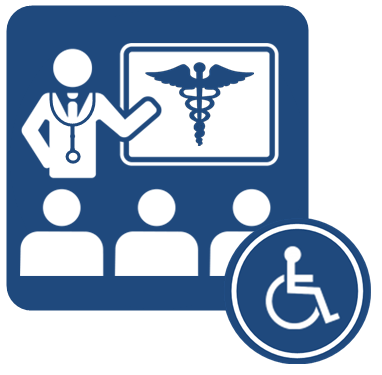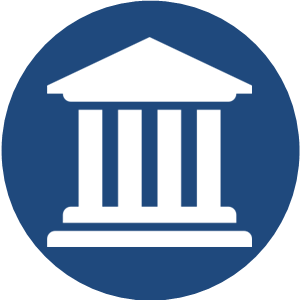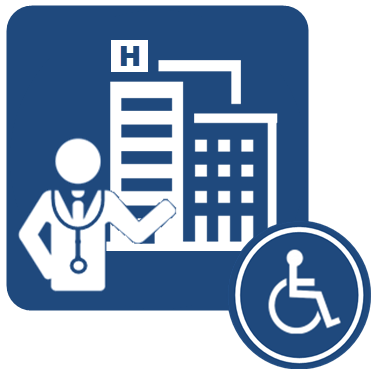Enhancing Accessibility for Deaf and Hard of Hearing Students in Medical Education
Stephanie Kuntz
Terminology
![]() This chapter will use terminology as defined by the Canadian Association of the Deaf (n.d.). The term deaf (with a lowercase “d”) will refer to individuals with little or no functional hearing. Deaf (with an uppercase “D”) will refer to individuals who engage in the culture, society, and language of the Deaf community, which is based on Sign language. Hard of hearing will refer to individuals with hearing loss whose usual means of communication is spoken language. The acronym DHoH (D/deaf and hard of hearing) will encompass all individuals with hearing loss. Identity-first language will be used, as is generally preferred by the DHoH community and in the literature.
This chapter will use terminology as defined by the Canadian Association of the Deaf (n.d.). The term deaf (with a lowercase “d”) will refer to individuals with little or no functional hearing. Deaf (with an uppercase “D”) will refer to individuals who engage in the culture, society, and language of the Deaf community, which is based on Sign language. Hard of hearing will refer to individuals with hearing loss whose usual means of communication is spoken language. The acronym DHoH (D/deaf and hard of hearing) will encompass all individuals with hearing loss. Identity-first language will be used, as is generally preferred by the DHoH community and in the literature.
The term disability will describe a wide range of lived experiences caused by the inaccessibility of services, lack of accommodation, and ableist expectations of others (Schumm, 2023). Though members of the Deaf (with an uppercase “D”) community are not disabled, individuals who are deaf (with a lowercase “d”) or hard of hearing may identify as having a disability due to the challenges they face living in a hearing-centric world (Schumm, 2023).
The sources referenced in this chapter will include both academic publications and accounts of barriers and solutions shared by DHoH medical trainees and physicians.
The Scope of Accessibility Barriers in Medical Education
 While efforts to improve diversity in healthcare education have increasingly focused on addressing gender and ethnic disparities, limited attention has been paid to medical trainees with varied accessibility needs (Hill et al., 2022). In 2023, the Canadian Resident Matching Service reported that 5.1% of both Canadian and international medical trainees self-identified as having a disability. This rate is far lower than the 22% prevalence in the general Canadian population (Gertsman et al., 2023). Individuals who are DHoH are similarly underrepresented in healthcare, especially among physicians (McKee et al., 2013). Although more than 15% of the general population experiences hearing loss, medical students with hearing loss represented only 0.01% of US medical school graduates between 2001 and 2010 (Argenyi, 2016).
While efforts to improve diversity in healthcare education have increasingly focused on addressing gender and ethnic disparities, limited attention has been paid to medical trainees with varied accessibility needs (Hill et al., 2022). In 2023, the Canadian Resident Matching Service reported that 5.1% of both Canadian and international medical trainees self-identified as having a disability. This rate is far lower than the 22% prevalence in the general Canadian population (Gertsman et al., 2023). Individuals who are DHoH are similarly underrepresented in healthcare, especially among physicians (McKee et al., 2013). Although more than 15% of the general population experiences hearing loss, medical students with hearing loss represented only 0.01% of US medical school graduates between 2001 and 2010 (Argenyi, 2016).
Over the past decade, the number of DHoH medical professionals has increased by 26%, yet there is still a lack of published strategies for designing inclusive medical education programs (Hill et al., 2022; National Deaf Center on Postsecondary Outcomes, n.d.). This gap is reflected in the experiences of Dr. Jessica Dunkley, Canada’s first Deaf and Métis doctor, who faced significant challenges when the University of British Columbia denied her request for Sign language interpreters, leading to her dismissal from the residency program. Five years later, the British Columbia Human Rights Commission and the Supreme Court of British Columbia ruled in her favor, acknowledging the discrimination she faced during her medical education (Moulton, 2017).
Accessibility Barriers and Proposed Instructional Design and Technology Solutions
 Physician education in Canada comprises at least three years of medical school, divided into pre-clinical and clinical stages. The pre-clinical stage focuses primarily on acquiring foundational biomedical knowledge, typically in large lecture halls and small group settings. After pre-clinical education, medical students move on to clinical education, where they rotate through various medical specialties, gaining hands-on experience in clinics, operating rooms, emergency rooms, and hospital wards. These clinical experiences allow students to translate theories learned in the classroom into professional practice (Fovet, 2021).
Physician education in Canada comprises at least three years of medical school, divided into pre-clinical and clinical stages. The pre-clinical stage focuses primarily on acquiring foundational biomedical knowledge, typically in large lecture halls and small group settings. After pre-clinical education, medical students move on to clinical education, where they rotate through various medical specialties, gaining hands-on experience in clinics, operating rooms, emergency rooms, and hospital wards. These clinical experiences allow students to translate theories learned in the classroom into professional practice (Fovet, 2021).
DHoH students face barriers at every stage of medical education, some unique to each aspect of training.
Ableism
![]() Ableism has long been entrenched in the culture of medicine and refers to a framework of thought and action that prefers certain types of bodies and minds over others (Agaronnik et al., 2021; Kaundinya & Schroth, 2022). A commonly reported concern regarding students with disabilities is the assumption that they will not be able to withstand the rigours of medical education or be able to undertake a broad scope of practice upon graduation (Gertsman et al., 2023). In medicine, implicit messages that students with accessibility needs do not belong often stem from institutional policies, customs, and rituals collectively known as the hidden curriculum. This hidden curriculum is shaped by everyday practices discouraging trainees from asking for help or missing shifts or classes. Frequent and subtle microaggressions, such as derogatory comments about disability accommodations from medical staff or peers, are disturbingly common (Gault et al., 2020).
Ableism has long been entrenched in the culture of medicine and refers to a framework of thought and action that prefers certain types of bodies and minds over others (Agaronnik et al., 2021; Kaundinya & Schroth, 2022). A commonly reported concern regarding students with disabilities is the assumption that they will not be able to withstand the rigours of medical education or be able to undertake a broad scope of practice upon graduation (Gertsman et al., 2023). In medicine, implicit messages that students with accessibility needs do not belong often stem from institutional policies, customs, and rituals collectively known as the hidden curriculum. This hidden curriculum is shaped by everyday practices discouraging trainees from asking for help or missing shifts or classes. Frequent and subtle microaggressions, such as derogatory comments about disability accommodations from medical staff or peers, are disturbingly common (Gault et al., 2020).
To ensure fair representation of DHoH students in medical education, conscious efforts must be made to promote a medical school culture that includes and values all students (Gault et al., 2020; Kaundinya & Schroth, 2022). Anti-ableism goes beyond rejecting ableism; it involves implementing actionable changes in medical school admissions criteria and curricula to foster a culture of inclusion in healthcare (Kaundinya & Schroth, 2022).
Admission Biases
 Bias entrenched in medical school admissions poses a significant barrier to accessibility for DHoH students. While the U.S., Australia, and New Zealand have national guidelines outlining the inclusion of applicants with disabilities, Canada lacks standardized guidance beyond the legal duty to accommodate to the point of undue hardship (Gertsman et al., 2023).
Bias entrenched in medical school admissions poses a significant barrier to accessibility for DHoH students. While the U.S., Australia, and New Zealand have national guidelines outlining the inclusion of applicants with disabilities, Canada lacks standardized guidance beyond the legal duty to accommodate to the point of undue hardship (Gertsman et al., 2023).
Technical standards refer to the essential abilities that medical students must possess to complete their education and practice medicine competently. In the U.S., 73% of medical schools used discriminatory language in their technical standards, and only 13% included mention of accommodating students with disabilities (Stauffer et al., 2022). In Canada, medical schools set their own technical standards, which are often vague. For example, Ontario medical schools require students to be able to “acquire all relevant sensory information” without clarifying the nuance of what is required (Council of Ontario Faculties of Medicine, 2016). The unclear wording of this technical standard may discourage applicants from applying to medical schools or declaring their accessibility needs (Gertsman et al., 2023; McKee et al., 2013). Additionally, Canadian medical school admission websites lack information on accommodations (Gertsman et al., 2023).
To address these barriers, technical standards should be revised to allow safe alternatives when certain skills cannot be performed, even with accommodations. Some schools in the U.S. address this by focusing on the necessary skills without prescribing the exact methods by which these skills must be demonstrated (Gertsman et al., 2023). For example, a physician should be expected to diagnose pneumonia, but this does not necessitate the ability to hear the lung sounds associated with pneumonia (McKee et al., 2013). Technical standards should also be updated regularly to reflect the improvements in accommodative technology (Kaundinya & Schroth, 2022). Finally, medical schools must provide publicly available resources for prospective students that detail how their programs are accessible. This increased transparency would empower students to apply to medical schools, knowing their accessibility needs will be met (Gertsman et al., 2023).
Barriers Faced During Pre-Clinical Education
 Pre-clinical education presents numerous potential barriers for DHoH learners, stemming from the physical learning environment and the overwhelming volume of information conveyed predominantly auditorily. Large lecture halls, in particular, may present barriers for DHoH students due to the ambient noise and challenges of lip reading, especially when the speaker is far away or is talking quickly (Karunaratne & Karunaratne, 2021). In small group settings, incomplete sight lines and rapid verbal exchanges with overlapping conversations can also be barriers (Karunaratne & Karunaratne, 2021).
Pre-clinical education presents numerous potential barriers for DHoH learners, stemming from the physical learning environment and the overwhelming volume of information conveyed predominantly auditorily. Large lecture halls, in particular, may present barriers for DHoH students due to the ambient noise and challenges of lip reading, especially when the speaker is far away or is talking quickly (Karunaratne & Karunaratne, 2021). In small group settings, incomplete sight lines and rapid verbal exchanges with overlapping conversations can also be barriers (Karunaratne & Karunaratne, 2021).
Accommodations in these settings may involve using interpreters or assistive technology. The term interpreter can refer to either a Sign language interpreter or an oral transliterator. A Sign language interpreter translates between Sign language and English, while oral transliterators silently repeat spoken English to facilitate lip-reading from a single, easily visible person (National Deaf Center on Postsecondary Outcomes, n.d.). In Canada, the main Sign languages are American Sign Language (ASL) and Langue des signes québécoise (LSQ). There is also a regional dialect, Maritimes Sign Language (MSL). Individuals accustomed to using Sign language should be aware that the ASL lexicon does not have specific signs for many medical terms. There is often a learning curve related to mastering the specialized jargon and terminology of medicine (Hill et al., 2022).
Assistive technology may take the form of speech-to-text services and assistive listening systems. Speech-to-text services, also called Computer Assisted Real-Time Translation (CART), provide visual text with nearly instantaneous translation of the spoken word. A CART provider types the speaker’s words on a stenographic machine connected to a computer with software to translate the stenographic code into English. The translation can be read on a mobile device, a computer screen, or projected onto a wall. CART can be provided remotely through an Internet and telephone link (David, 2008).
Assistive listening systems represent another form of assistive technology. These systems enhance sound quality for individuals with incomplete hearing loss and can be considered “binoculars for the ears.” They differ from hearing aids as hearing aids amplify all sound, but assistive listening systems enhance hearing in specific settings by reducing background noise. Assistive listening systems can range from small, portable devices to preinstalled systems built into rooms. The many different assistive listening systems present unique advantages that can be tailored to different settings and user needs. Medical students at the University of British Columbia can borrow portable assistive listening systems from Assistive Technology BC at no cost (Lui, 2019). Lecturers should be aware that students using a portable assistive listening system cannot hear classmates’ comments unless they speak with a microphone. Lecturers should repeat brief comments from other students or pass the microphone to students making longer comments (National Deaf Center on Postsecondary Outcomes, n.d.).
In addition to interpreters and assistive technologies, note-takers can be used so that DHoH students can focus on accessing information without diverting their eyes from the source of information. Educators should also share their materials in advance and supplement lectures with captioned media. Learning environments should be designed to give all audience members a clear sight of the speaker. Adequate lighting is important for lip reading and watching interpreters (David, 2008).
Another potential barrier in pre-clinical education stems from assessments such as non-traditional “bellringer exams” frequently used to evaluate anatomy, pathology and radiology knowledge. During bellringer exams, students rotate through stations, identify anatomical structures, and answer related questions. General instructions during assessments are often given verbally (Lui, 2019). Similarly, bells, as the name implies, notify students when a station is over or ends early (Lui, 2019). This reliance on auditory information poses a barrier for DHoH students, as they may miss crucial verbal instructions, time warnings, and auditory signals. To address this barrier, multiple modalities should be used to convey key information during assessments, and visual alarms should be used in addition to auditory notifications (David, 2008).
Barriers Faced During Clinical Education
 Transitioning from a classroom to a clinical environment is a distinct aspect of medical education that presents unique barriers for DHoH students. Spoken communication is especially challenging to process in emergency departments and hospital wards due to high noise levels and poor environmental engineering (Chodosh et al., 2020). DHoH students may use an interpreter, a text-to-speech service, or an assistive listening system to overcome this barrier (Meeks et al., 2018). If an interpreter is used, this should include coverage for regular clinic hours and hours spent “on-call”, which can amount to greater than 60 hours of interpreter engagement per week. Two interpreters may be required in situations where interpreting could be prolonged (Hill et al., 2022). Medical educators can also improve emergency department and hospital ward teaching if conducted in smaller groups with an effort made to face the DHoH student while talking (Karunaratne & Karunaratne, 2021).
Transitioning from a classroom to a clinical environment is a distinct aspect of medical education that presents unique barriers for DHoH students. Spoken communication is especially challenging to process in emergency departments and hospital wards due to high noise levels and poor environmental engineering (Chodosh et al., 2020). DHoH students may use an interpreter, a text-to-speech service, or an assistive listening system to overcome this barrier (Meeks et al., 2018). If an interpreter is used, this should include coverage for regular clinic hours and hours spent “on-call”, which can amount to greater than 60 hours of interpreter engagement per week. Two interpreters may be required in situations where interpreting could be prolonged (Hill et al., 2022). Medical educators can also improve emergency department and hospital ward teaching if conducted in smaller groups with an effort made to face the DHoH student while talking (Karunaratne & Karunaratne, 2021).
Masking is another barrier encountered during clinical education. During the COVID-19 pandemic, 95% of individuals with hearing loss cited masks as an obstacle to communication (Chodosh et al., 2020). Many clinical settings still require learners to wear face masks. By default, hospitals only stock opaque face masks, which block lip movement visualization and muffle high-frequency sounds essential to speech (Chodosh et al., 2020; Meeks et al., 2015). To address this barrier, transparent surgical masks with a clear window over the mouth can facilitate lip-reading (Meeks et al., 2015). Unfortunately, there are not, as of yet, any windowed N95 masks for interacting with patients with airborne infections (Lui, 2019).
Clinical rotations involving operating rooms have their own unique set of barriers (Meeks et al., 2015). In addition to mandatory masking, learners must follow verbal instructions from supervisors while simultaneously monitoring patients and equipment that use alarms to alert the care team (Meeks et al., 2015). To address these barriers, Sign language interpreters should be allowed in surgical suites. If space is a limiting factor, or if the learner does not use Sign language, CART and/or assistive listening systems may be used with some adaptations (Meeks et al., 2015). For monitors that alarm using sound, a vibrating alarm attached to a beeper or other small device can alert DHoH students. Students may also benefit from reviewing anticipated surgical cases one-on-one with a surgical team member before each surgery. This may assist the student in familiarizing themselves with the procedure, vocabulary, anticipated outcome, potential concerns, and the techniques being used (Meeks et al., 2015).
Finally, many medical professionals rely on auscultation (the act of listening to internal sounds of the body) to examine the status of the circulatory, respiratory, and gastrointestinal systems (Rabinowitz et al., 2006). It is a common misconception that DHoH learners cannot use a stethoscope, which is required for auscultation. Stethoscopes come in many varieties and may be acoustic (traditional, unamplified) or amplified, providing amplification up to 40 times with noise cancellation. Some amplified stethoscopes have an audio output jack that can be attached to a recording device, a second listener, headphones, or an assistive listening system. Some stethoscopes can also stream through hearing aids or cochlear implants (Lui, 2019). In addition to stethoscopes, some physicians may use portable ultrasounds to help visualize what the stethoscope is capturing (Lui, 2019). Non-auditory stethoscopes connect to a laptop or personal digital assistant and display visual representations of auscultated sounds (Rennert et al., 2004).
Conclusion
Accessibility gaps must be addressed in medical education. Not only is failing to do so a violation of human rights, but welcoming DHoH students in medical education enriches the experiences of DHoH learners, peers, practicing physicians, and patients. Including DHoH students in medical education offers an experiential way to educate peers and faculty on DHoH accessibility and helps shift the perception of DHoH persons from patients to colleagues. Moreover, DHoH medical students and physicians often act as role models and mentors for those who aspire to medical careers previously thought out of reach. DHoH physicians can also provide linguistically accessible and culturally appropriate health care to DHoH patients historically marginalized in the health care system. At the very minimum, Deaf patients should have access to ASL-fluent doctors (McKee et al., 2013).
By addressing barriers at each stage of medical education, institutions can foster a culture of inclusion and support. Educating DHoH physicians should prioritize outcomes, accessibility training for educators, and support the use of interpreters and assistive technologies when requested. Admission committees, faculty, and administrators should also recognize the diversity within the DHoH community in medicine and actively engage DHoH learners to identify their preferred accessibility solutions across various settings (McKee et al., 2013).
References
Agaronnik, N. D., Saberi, S. A., Stein, M. A., & Tolchin, D. W. (2021). Why disability must be included in medical school diversification efforts. AMA Journal of Ethics, 23(12), 981–986. https://doi.org/10.1001/amajethics.2021.981
Argenyi, M. (2016). Technical standards and Deaf and hard of hearing medical school applicants and students: Interrogating sensory capacity and practice capacity. AMA Journal of Ethics, 18(10), 1050–1059. https://doi.org/10.1001/journalofethics.2016.18.10.sect1-1610
Chodosh, J., Weinstein, B. E., & Blustein, J. (2020). Face masks can be devastating for people with hearing loss. BMJ, m2683. https://doi.org/10.1136/bmj.m2683
Council of Ontario Faculties of Medicine. (2016). Essential skills and abilities required for entry to a medical degree program. https://cou.ca/reports/essential-skills-study-of-medicine/
David, M. (2008). Universal design and barrier-free access guidelines for persons with hearing loss. Canadian Hard of Hearing Association. https://www.chs.ca/sites/default/files/uploads/universal_design_and_barrier-free_access_hardofhearing.pdf
Fovet, F. (Ed.). (2021). Handbook of research on applying universal design for learning across disciplines: Concepts, case studies, and practical implementation. IGI Global. https://doi.org/10.4018/978-1-7998-7106-4
Gault, M. A., Raha, S. S., & Newell, C. (2020). Perception of disability as a barrier for Canadian medical students. Canadian Family Physician, 66(3), 169–171.
Gertsman, S., Dini, Y., Wilton, D., & Neilson, S. (2023). Tackling barriers in Canadian medical school admissions for students with disabilities. Canadian Medical Association Journal, 195(44), 1512–1516. https://doi.org/10.1503/cmaj.230734
Hill, C., Deville, C. J., Kiess, A., Narang, A., Ratnanather, T., Bienstock, J., Brinckerhoff, L., Hodukavich, A., Anderson, R., Alcorn, S., DeWeese, T., Viswanathan, A., & Page, B. R. (2022). Establishing a Deaf and American Sign Language inclusive residency program. Academic Medicine, 97(3), 357. https://doi.org/10.1097/ACM.0000000000004469
Karunaratne, N., & Karunaratne, D. (2021). The implications of hearing loss on a medical student: A personal view and learning points for medical educators. Medical Teacher, 43(11), 1333–1334. https://doi.org/10.1080/0142159X.2020.1839036
Kaundinya, T., & Schroth, S. (2022). Dismantle ableism, accept disability: Making the case for anti-ableism in medical education. Journal of Medical Education and Curricular Development, 9, 23821205221076660. https://doi.org/10.1177/23821205221076660
Lui, A. (2019). Navigating medical school with hearing loss. Canadian Federation of Medical Students. https://www.cfms.org/files/external-documents/Hearing_Loss_in_Medical_School_Sep_2019.pdf
McKee, M. M., Smith, S., Barnett, S., & Pearson, T. A. (2013). Commentary: What are the benefits of training deaf and hard-of-hearing doctors? Academic Medicine, 88(2), 158–161. https://doi.org/10.1097/ACM.0b013e31827c0aef
Meeks, L. M., Engelman, A., Booth, A., & Argenyi, M. (2018). Deaf and hard-of-hearing learners in emergency medicine. Western Journal of Emergency Medicine, 19(6), 1014–1018. https://doi.org/10.5811/westjem.2018.8.38550
Meeks, L. M., Laird-Metke, E., Rollins, M., Gandhi, S., Stechert, M., & Jain, N. R. (2015). Accommodating deaf and hard of hearing students in operating room environments: A case study. Journal of Postsecondary Education and Disability, 28(3), 383–388.
Moulton, D. (2017). Physicians with disabilities often undervalued. Canadian Medical Association Journal, 189(18), 678–679. https://doi.org/10.1503/cmaj.1095402
National Deaf Center on Postsecondary Outcomes. (n.d.). Access & Accommodations. Retrieved June 3, 2024, from https://nationaldeafcenter.org/resources/access-accommodations/
Rabinowitz, P., Taiwo, O., Sircar, K., Aliyu, O., & Slade, M. (2006). Physician hearing loss. American Journal of Otolaryngology, 27(1), 18–23. https://doi.org/10.1016/j.amjoto.2005.05.014
Rennert, N., Morris, R., & Barrere, C. (2004). How to cope with scopes: Stethoscope selection and use with hearing aids and Cls. Hearing Review, 11(2), 34–41.
Schumm, M. (2023). The use of universal design for better inclusion of people who are Deaf/hard of hearing or have other invisible disabilities in environmental education. https://digitalcommons.hamline.edu/hse_cp/929/
Stauffer, C., Case, B., Moreland, C. J., & Meeks, L. M. (2022). Technical standards from newly established medical schools: A review of disability inclusive practices. Journal of Medical Education and Curricular Development, 9, 23821205211072763. https://doi.org/10.1177/23821205211072763
